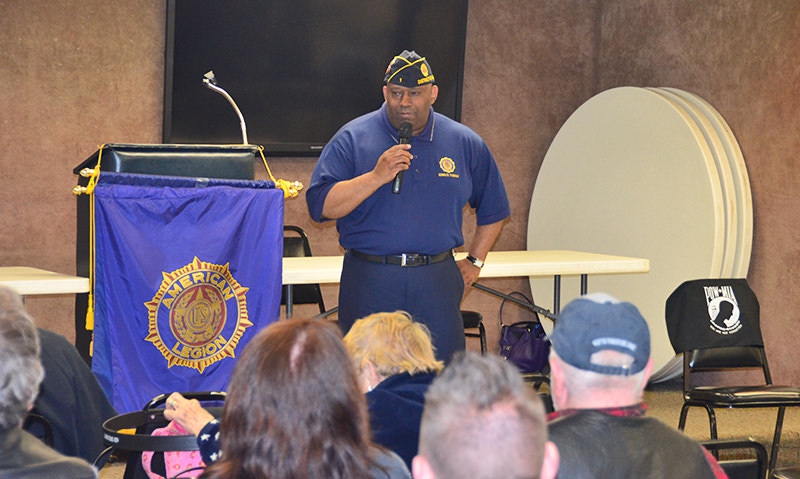p1.jpg.jpg)
Veterans express both frustration and gratitude for VA care during an American Legion town hall in Fort Wayne, Ind.
Chad Adamson served in the Army from 1994-1998 and the Army reserve from 1998-2000. He’s got back pain as a result of that service and repeatedly went to the Marion campus of the VA Northern Indiana Health Care System (VANIHCS).
Adamson said he got “X-ray after X-ray” before going to an outside doctor for treatment. When the doctor asked for his MRI results, Adamson told her he’d never been provided one by the Department of Veterans Affairs.
“For eight years they were telling me I have no issue,” Adamson said of his VA providers. “I was starting to think I’m delusional – do I really have pain? They were trying to convince me I don’t have this pain I truly have.”
Adamson was able to voice his frustration with his VA care during an April 23 American Legion town hall at American Legion Post 241 in Fort Wayne, Ind. VA employees, including VANIHCS Chief of Staff Dr. Wayne McBride, were on hand to listen to those concerns and try to offer solutions.
The town hall was part of the Legion’s System Worth Saving visit to VANIHCS, which has facilities in both Marion and Fort Wayne. The visit brings American Legion national staff together with Department of Indiana Legionnaires to meet with VA staff and discuss both progress made and concerns the Legion and the veterans in the area still have.
McBride apologized to Adamson for the difficulty in getting the MRI, telling Adamson “I do believe that is not the norm. It happens occasionally.”
Dan Martin, who served in the U.S. Navy from 1985-1991, and is a member of American Legion Post 10 in Marion, said he’s been treated in “probably 10 different” VA facilities across the country. “I’ve seen the best and the worst of VA,” he said. “I will say that Northern Indiana has some of the best doctors (and) nurses. Dedicated folks.”
But Martin said he’s frustrated because he’s been trying to get an epidural administration for his back for three weeks. He said an outside doctor he was using through VA’s Choice Program referred him to a pain doctor.
“Somebody (at VANIHCS) told me, ‘You can’t go there. You’re going to have to drive up to Fort Wayne and get a shot in your back,’” Martin said. “I’m still waiting for that. I sure would like to get this pain shot squared away. The Choice doctor did approve it. I got to the doctor on Monday, and he thought it was serious enough (to get the shot) on a Tuesday. (VANIHCS) said, ‘No, you can pay for it yourself or you can drive to Fort Wayne VA and have a VA doctor do it.' That doesn’t seem right, especially when I’m down in Marion.”
Frustration aside, Martin still said he preferred VA care over the private sector experience. “When I’m in that (private sector) waiting room, I’m just like everybody else,” he said. “It’s uncomfortable. But in that time I’m at the VA … I get to wear the uniform again. I get to be around my brothers and my sisters.”
One veteran with a background in health care asked how VANIHCS was keeping up with new modalities and innovations being used in the civilian world. “The VA, over the years, has really led in a lot of ways with innovations and with a lot of new techniques and medical approaches,” McBride said, citing examples such as prosthetic limbs and genomics. “Many of these things are happening in the VA. Most of the time these have been partnerships with large medical schools. It does occur frequently.”
Another veteran expressed concern over the turnover rate among VANIHCS providers, saying he has one meeting with the provider and then the provider leaves the system for another job. “Like many organizations, we have a certain measure of turnover,” McBride said. “In the last year or two we’ve had a greater measure of stability. We recognize the importance of having a stable primary-care provider.”
McBride was asked what his health-care system was doing to combat the opioid crisis that the nation faces and said VANIHCS was following VA’s Opioid Safety Initiative. He said the initiative is designed to help taper veterans off opioids while VA provides other forms of pain management that could include seeing a chiropractor or physical therapist.
“Have we been perfect? No,” McBride said. “Have we been doing a lot better in the last few years? Of course.”
Another veteran said that VA does care about its patients, rather than just bottom-line numbers, while Grant County Service Officer and Legionnaire Allen Connelly said he also makes it a point to ask veterans how their VA experience has gone. “I can tell you that at least 95 percent of them are very positive,” he said. “So you are doing something right.”
Edwin Thomas, assistant director for Health Policy in the Legion’s Veterans Affairs & Rehabilitation Division in Washington, D.C., promised that when he and other Legionnaires would meet with McBride and other VA staff the day after the town hall, “We will be advocating on your behalf. There are a whole lot of things that the VA does – good things – but we also know there are some things that they can approve on. We provide an extra set of eyes.”
Jorge Ortiz, Sen. Joe Donnelly’s Northeast Regional Director and a second lieutenant in the Indiana National Guard, said town halls such as the one the Legion facilitated are critical in advancing veterans’ issues.
“I think it’s really important for veterans to be able to speak up on issues, especially regarding their care,” Ortiz said. “I know over the past few years we’ve worked legislatively on issues like Choice and just expanding more access to health care for veterans, and none of those (would be accomplished) without veterans speaking up.”
- Veterans Healthcare

